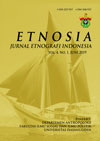Abstract
This study aims to describe and analyze the symbols of movements and costumes used from martial arts as a cultural identity that is present and attached to the Sulawesi Pencak Silat Association (IPS). The study used a qualitative descriptive approach with ethnographic methods. This research was conducted in Padepokan Pencak Silat Sulawesi Association (IPS) in Taeng Village, Gowa Regency. The analysis technique used is symbolic interpretation, which sees symbols and meanings going hand in hand from each movement used. This research shows that silat or manca tidak is not talking about stance as a form of organized movement, but rather on the functions, benefits, risks posed. The parts of silat contain meanings and symbols that are understood as cultural identity and forms of belief, namely: the fingers describe three in one form of respect, stepping with the right foot first, the foot is always shaped like an easel.
References
Abbas, Rustam; dkk. (2014). Permainan Rakyat Sulawesi Selatan. Cetakan pertama. Makassar.De La Macca.
Alexander, Howard., Quintin Chambers., and Donn F. Draeger. (1972). Pentjak SIlat The Fighting Art of Indonesian Fighting Art. Tokyo: Kodansha
de Castella, T. 2006. Work Experience: Uanu seshmi, director, from boyhood to manhood. Regeneration & Renewal, 24. Retrieved from "https://search.proquest.com/docview/230688888?accountid=38628" [17/07/19]
Geertz, Clifford. 2014. The Interpretation of Cultures. Yogyakarta PT. Karnisius anggota IKAPI
Gilang, Moh. Dkk. (2007). "Penjasorkes SMA kls 12", Ganeca Exact, 9795712578, 9789795712572.
Jundana. 2017. Gandrang Pamancak Dalam Upacara Perkawinan Adat Makassar Di Gowa Sulawesi Selatan. Skripsi Jurusan Etnomusikologi Fakultas Seni Pertunjukan Institute Seni Indonesia. Yogyakarta.
Kinasih, Sri. E. (2009). Buku Ajar Antropologi Hukum. Surabaya: PT. Revka Petra Media.
Kristanto, Nurdien Harry. 2015. Tentang Konsep Kebudayaan. Fakulta Ilmu Budaya Universitas Diponegoro. Jurnal.Undip.ac.id Vol.10 No.2
Koentjaranigrat. (2003). Pengantar Antropologi. Jakarta: Penerbit Rineka Cipta
Mahendra, A. (2013). Konstruksi Identitas Sosial Perguruan Pencak Silat Pencak Organisasi Ranting Kecamatan Sidoarjo, Kabupaten Sidoarjo. Journal Universitas Airlangga Volume 2 Nomor: 2, Juli 2013.
Mardotillah, Mila, & Dian Mochammad Zien. Silat: Identitas Budaya, Pendidikan, Seni Bela Diri, Dan Pemeliharaan Kesehatan. JURNAL ANTROPOLOGI: Isu-Isu Sosial Budaya. Desember 2016 Vol. 18 (2): 121-133_ISSN 1410-8356.
Majalah Gema Pencak Silat Tahun ke-4 No 1 Januari 2000
Mulyono, Agoes Tri, dkk. (2012). Silat Tradisional Minangkabau. Padang: Dewan Kesenian Tanah Datar.
Setyo, E.K. (2015). Pencak Silat. Yogyakarta: pustaka baru press
Suwaryo, (2008). Peranan Organisasi Perguruan Seni Beladiri Pencak Silat Dalam Meminimalisasi Kejahatan (Suatu Studi Upaya Non-Penal Pada Organisasi Perguruan Seni Beladiri Pencak Silat Di Kabupaten Banjarnegara, Provinsi Jawa Tengah). Program Magister Ilmu Hukum Program Pascasarjana Universitas Diponegoro Semarang.
Sutton, R.A. (2013). Pakkuru Sumange’: Musik, Tari dan Politik Kebudayaan Sulawesi Selatan., Makassar: ININNAWA.





